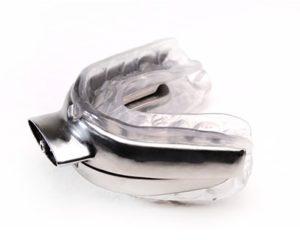Several years ago, I worked at a medical clinic that specialized in treating sleep disorders, particularly sleep apnea. Nothing about the process of diagnosis and treatment was fun for the patients – some of them had to return for multiple sleep studies, only to have immense difficulty adjusting to the often uncomfortable CPAP masks and machines. I spoke with more than one patient who would call the office in tears of frustration – I felt terrible for them.
I was intrigued, then, when I heard about Oventus Medical and the 3D printed sleep apnea device they had developed. The O2Vent, a customizable titanium device fitted to each patient’s mouth, delivers a steady stream of air to the back of the mouth, preventing obstruction and, apparently, doing so much more comfortably than a cumbersome, claustrophobic CPAP mask.
The 3D printed device has shown a lot of promise thus far, receiving FDA approval for release in the United States in September. Today, Oventus took a big next step with the opening of a new 3D printing facility in their home country of Australia. The facility is located at the Clayton site of the Commonwealth Scientific and Industrial Research Organisation (CSIRO), which played a role in the development of the device.
“Combining our research team’s additive manufacturing experience with the software capabilities of CSIRO’s Data61, meant we could create a one stop in-house process for making personalised mouth pieces that are individualised for each Oventus customer,” said Dr. Keith McLean, Research Director of CSIRO Manufacturing. “Additionally, we have been able to help Oventus upscale their manufacturing process to allow large volume manufacturing of the devices at the Clayton facility.”
Clayton, a suburb of Melbourne, is home to only one of CSIRO’s multiple locations, both in Australia and overseas. Oventus’ new facility is adjacent to CSIRO’s Lab 22 additive manufacturing center, which opened last year. That center was instrumental in the development of the O2Vent, as were CSIRO’s advanced computational modeling resources.
“CSIRO were able to help us not only develop the 3D printing process, but also create the crucial software needed to design the individual devices,” said Dr. Chris Hart, founder of Oventus. “Because a patient’s bite is as individual as his fingerprint, we needed special software to help us create a perfectly customised O2Vent from a patient’s dental imprints.”
The opening of the new additive manufacturing facility is just one marker of what is shaping up to be a bright future for Oventus. The company was recently listed on the Australian Securities Exchange after raising $12 million in their initial public offering, and is on track to see significant revenue growth beginning in fiscal year 2017. Oventus will also be launching in the US in the first part of 2017, where over 37 million people suffer from snoring or sleep apnea. So if any of the patients I used to work with are reading this, hang in there – there’s a new option coming, and it looks like it’s going to be much more comfortable and effective than yesterday’s problematic CPAP machines. Discuss in the Oventus forum at 3DPB.com.
Subscribe to Our Email Newsletter
Stay up-to-date on all the latest news from the 3D printing industry and receive information and offers from third party vendors.
You May Also Like
3D Printing Unpeeled: Wind Turbines, Probiotics and Lenses
TPI Composites, ORNL and Ingersoll Rand are working to make wind turbine tooling segments that can be 18.3 meters long. These elements also include resistive wires that help keep the...
3D Printing Unpeeled: Digital FDM Filament for Functional Gradients
Just published in Nature, a paper by a Seoul National University team looks at “3D printing with a 3D printed digital material filament for programming functional gradients.” Sang-Joon Ahn, Howon...
3D Printing Unpeeled: $5000 Cold Spray 3D Printer, Roland DGA & Living Materials
The AeroForge is a $5000 cold spray metal printer for copper made by a student team at Rice University. In a paper for ACS Central Science a team from Nanjing...
3D Printing Webinar and Event Roundup: April 28, 2024
In this week’s 3D Printing Webinar and Event Roundup, the Ceramics Expo is taking place in Michigan, Stratasys continues its advanced training courses, and SPE is holding a Polymer Characterization...


































